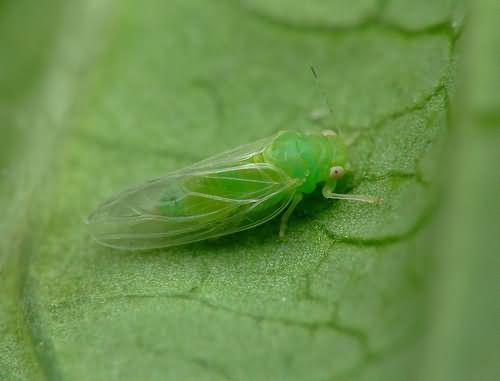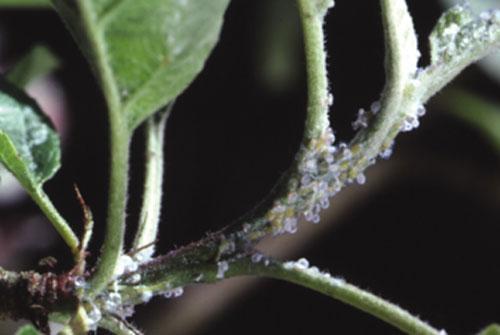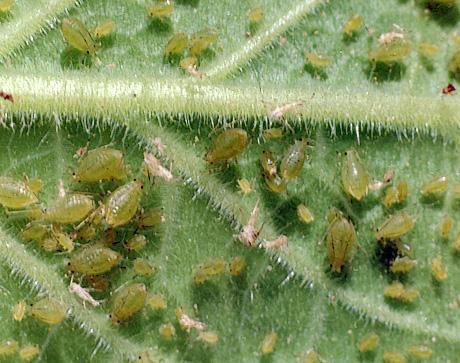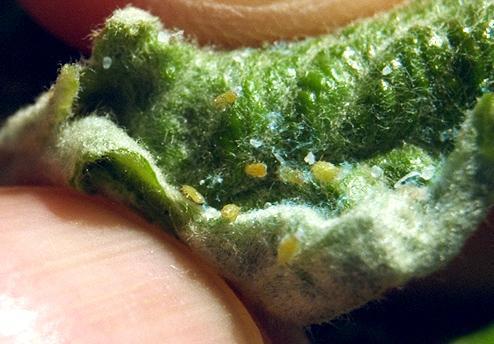The apple sucker (Psylla mali) – pest management

The apple sucker, Psylla mali, is a widespread species in the temperate area of Europe, North America, Australia, and South Africa
Description. The adult has a variable body color, depending on the season, with a length of 3.3-3.8 mm in the case of males and 3.6-4 mm in the case of females. The summer forms have the body color green-yellow, with the head and thorax green-gray, and the abdomen intense green. The first stage larva has a flattened body (dorsoventrally), yellow in color, and the larvae of the second stage have the abdominal extremity covered with a white or light blue filamentous waxy secretion. The egg is elongated, initially yellow, then darker (orange, dark red), 0.4 mm long and it is attached to the substrate with a fine pedicle.




Biology and ecology
It produces one generation per year. It overwinters in the egg stage, which was laid in the cracks of the branches’ bark, on the young branches, from where the buds sprout, on the scales of the buds. The larvae migrate to the flower and vegetative buds, on which they feed by stinging and sucking the intracellular fluid. The attacked organs are covered by their sweet droppings “honeydew”. Towards the end of flowering, the larvae turn into adults, which remain on the leaves without causing damage. Laying the eggs takes place in late August, early September, alone or in small groups of 3-10 eggs, especially on the side of the tree that is less exposed to the wind.
Attacked plants and damages. The apple leaf sucker attacks the apple tree. It first colonizes the flower and vegetative buds, then the leaves and young fruits. As a result of the stinging of the shoots, they no longer develop normally, they twist, the young leaves deform, and remain small, with a chlorotic appearance. The flower buds fall and dry out, and their stems remain hanging on the branches for a long time. The attacked organs are covered by sweet droppings (honeydew) on which Capnodium fungi (sooty mold) grow. Because of this, a black layer is formed on various attacked organs, which reduces photosynthesis.
Control. The best time to fight the larvae is in spring, before flowering, or when 10-15% of the flowers have shaken their petals.
Recommended products
-
You can find products on a different store
Change Store -
You can find products on a different store
Change Store -
You can find products on a different store
Change Store -
You can find products on a different store
Change Store -
You can find products on a different store
Change Store -
You can find products on a different store
Change Store -
You can find products on a different store
Change Store -
You can find products on a different store
Change Store -
You can find products on a different store
Change Store -
You can find products on a different store
Change Store -
You can find products on a different store
Change Store -
You can find products on a different store
Change Store -
You can find products on a different store
Change Store -
You can find products on a different store
Change Store -
You can find products on a different store
Change Store -
You can find products on a different store
Change Store -
You can find products on a different store
Change Store -
You can find products on a different store
Change Store -
You can find products on a different store
Change Store -
You can find products on a different store
Change Store -
You can find products on a different store
Change Store -
You can find products on a different store
Change Store -
You can find products on a different store
Change Store -
You can find products on a different store
Change Store















































































































































































































































































































































































































































